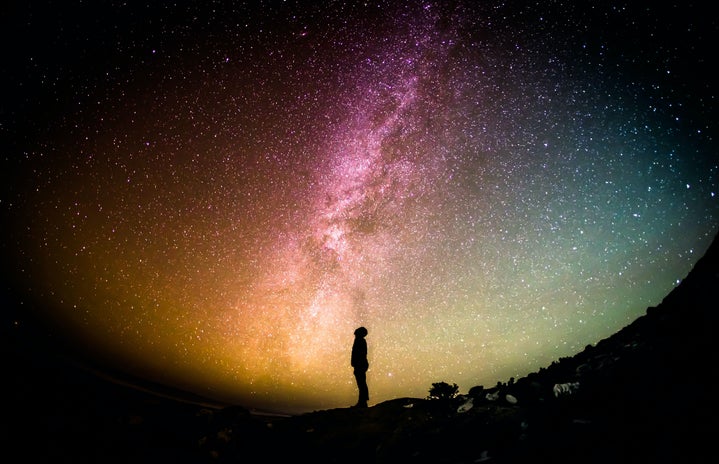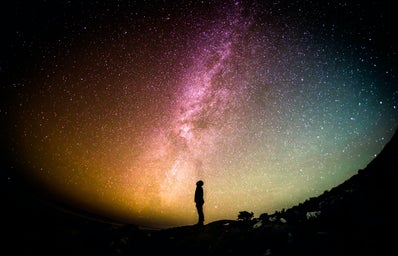“and the universe said I love you.” – Julian Gough, End Poem
As a child, I had an extremely specific recurring fantasy about stars. In a forest clearing on an unfamiliar mountain, I would see myself sitting by a dead campfire with friends. It was always autumn in this scenario, which was mildly odd coming from the imagination of a tropical islander. But nothing was odder to my city-dweller brain than the fact that there would always be stars visible in the sky.
Growing older, practicality and pragmatism tend to take center stage in our lives, and for many, childhood dreams of fun and fancy lay forgotten by the wayside. As students, we’ve replaced giant robots with even bigger projects, and the time we used to spend creating stories is now spent on building our future careers. (Which, by the way, is mostly a good thing.)
However, I’ve seen many friends and strangers break down over the pressure of deadlines and piling responsibilities. Often, these things can seem all-consuming, whittling away at your energy and motivation until all you can think about is not dropping the ball at any cost.
But when you’ve reached your limit, it does drop.
And it shatters.
And suddenly it feels as if that ball had been the entire world in your hands.
The thing is, when our hands are bloody with the shards of a shattered globe, we tend to forget that all around us, there are stars.
For me, the process of remembering again was quite literal.
In August of 2003, NASA’s Jet Propulsion Laboratory and Caltech launched the Spitzer Space Telescope. Named after the man who conceived the idea of putting telescopes in space, Spitzer was an infrared telescope tasked with furthering our understanding of the cosmos. I say “was” because eight months ago, on the 30th of January, 2020, the Spitzer Space Telescope’s mission came to a close.
Fortunately, before Spitzer bid its final farewell, it left us with plenty of gifts. Among them, the first direct detection of exoplanets, the discovery of the Double Helix Nebula, and my personal favorite: GLIMPSE. Short for Galactic Legacy Infrared Mid-Plane Survey Extraordinaire (and who says scientists are bad at naming things?), GLIMPSE shows you what at first seems like an unassuming image. Zoomed out to its full length, it’s a choppy, puzzle piece-looking band of tiny dots. But zooming in further and further, we aren’t greeted by blurry pixels; rather a crisp, clear mosaic of the stars in every direction.
GLIMPSE isn’t just one ridiculously long image of the Milky Way Galaxy; it’s a collection of over two million snapshots taken over the span of more than 10 years, pieced together to form one ridiculously long collage of the Milky Way Galaxy. And because Spitzer is an infrared telescope, it’s able to bypass the giant gas clouds throughout the void, showing us more than we could ever hope to see with the naked eye.
Believe me, that’s a lot of stars.
When we peer out at our home galaxy through Spitzer’s lens, we find ourselves gazing at an unfiltered view of the universe from Earth’s perspective. A rock, floating silently in the farther region of one of our galaxy’s many spiral arms. Far away from the glowing hubbub at its center, and yet still surrounded in all directions by light.
I discovered the GLIMPSE 360 viewer back in late January, that same week the Spitzer Space Telescope retired forever. This was right around the peak of its fame. There were Spitzer-related headlines left and right, and it seemed that every online science educator was talking about it.
Coincidentally, it was also finals season.
So many people I knew — and many, many more people I didn’t know — had been stressed out in this period of time. Some were worried about smaller-scale issues like finals, or university acceptances, others about the news of COVID-19 that had just started to trickle in. In the countries that were hit by the earliest waves of the pandemic, quarantines and shutdowns of public facilities had already begun. All this compounded with the already pretty bad state of the world before the pandemic, and what else can be said other than there was a lot of messy stuff going on.
But somewhere in the middle of all that noise, one special space telescope showed the world a galaxy full of stars, and I found myself back in a forest clearing on an unfamiliar mountain, sitting around a dead campfire with friends. And I was thankful.
Not because some random image somehow immediately solved all the world’s problems, but because that image allowed me to momentarily step away from them and give myself a bit of time to clear my head and think, to pick up the shards of my shattered globe and (both literally and metaphorically) look up at the stars.
Wonder isn’t going to save the world, but it doesn’t need to. All it has to do is inspire us to keep going, even when it seems like the world is beyond saving.
Of course, not everyone is super into outer space stuff, but there’s always something to think about. All the species of living things we have yet to discover and categorize, all the people we have yet to meet in this vast, varied human society, all the books we could never hope to read within our short lifetimes. Anything to provide a little wonder in a time of chaos.
Because oh boy, this year has definitely been one hell of a time of chaos.
It’s not a cure-all, but when feeling overwhelmed, I definitely recommend taking a second to look around and find your own stars.


